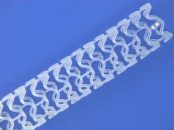Courtesy of Dr. Agustín Vecchia. Since 1990, radial access has progressively gained ground, currently becoming the default technique in most endovascular intervention centers. One of its few associated complications is radial artery occlusion. While most frequently clinically silent and non-serious, this complication could hinder the performance of future procedures in the patient and, in some…
Procedural Complexity Affects Decision-Making Regarding DAPT Duration
Much of the speculation around the way of individualizing dual antiplatelet therapy (DAPT) duration after coronary angioplasty has focused on clinical parameters (e. g., diabetes), but a new study published by the Journal of the American College of Cardiology (JACC) and presented at the last European Society of Cardiology (ESC) Congress warns about anatomical factors as…
Contrast Induced FFR: Cost and Time Effective Alternative
Courtesy of Dr. Guillermo Migliaro. Fractional flow reserve (FFR) is the radio of two flows expressed as the ratio of two pressures ─ distal pressure across stenosis (Pd) to aortic pressure (pa) ─ obtained only under maximal coronary hyperemia, which is a state of drug induced maximal vasodilation. The gold standard to create…
Coronary Perforation in PCI: Associated to Negative Outcomes
Courtesy of Dr. Guillermo Migliaro. Coronary perforation (CP) is a rare but serious complication of percutaneous coronary intervention (PCI) with an estimated incidence of 0.5%. Arterial blood entering the pericardium may cause a rapid elevation of intrapericardial pressure and collapse the right cavities (tamponade) creating hemodynamic compromise. Historically, surgical drainage has been the…
A New Indicator to Assess Stenosis Severity
This study looked at the role of fractional myocardial mass (vessel-specific myocardial mass) in the assessment of stenosis physiological severity. Researchers used CT angiography to study this new concept of myocardial mass subtended by a specific vessel, which could reduce anatomical-physiological mismatch. The study included 463 patients with 724 lesions evaluated by multislice…
Closure Devices vs. Manual Compression
Courtesy of Dr. Guillermo Migliaro. Post PCI major bleeding has been associated with short term mortality in acute coronary syndromes (ACS). Even though studies have shown the transradial approach is safer than the femoral, especially in high risk subgroups ─ mainly STEMI patients ─ the femoral access site continues to be widely used. …
Stem Cells: A New Alternative for Refractory Angina?
Courtesy of Dr. Agustín Vecchia. Recent investigations and certain randomized trials suggest that the administration of CD34+ stem cells to patients with refractory angina improves exercise tolerance and decreases angina frequency. The following is a phase 3, randomized, double-blind multicenter trial comparing three groups of patients: active treatment through intramyocardial administration of CD34+ stem cells (autologous, purified), standard of care…
BVS: Comparable to Second-Generation DES in Complex Lesions
A center carrying out a mid- to long-term follow-up of the performance of everolimus-eluting bioresorbable scaffolds (Absorb) observed that this new device has an acceptable rate of major cardiovascular events, when compared to second-generation drug-eluting stents. Furthermore, although the population was complex and non-selected, no cases of early thrombosis were reported. This study enrolled 249 patients…
Visual Assessment and Misinterpretation of Coronary Lesion Severity
Courtesy of Dr. Pablo Baglioni. The visual interpretation of coronary angiographies is still used to decide for or against revascularization of ambiguous coronary lesions. Multiple factors other than stenosis degree, have been associated with the functional significance of lesions. The aim of this study was to analyze the ability of interventionists to visually assess…
All-Spectrum Transradial Approach: Safer than Femoral
Original Title: Radial vs femoral access for coronary interventions across the entire spectrum of patients with coronary artery disease: a meta-analysis of randomized trials. Reference: Ferrante G et al. J Am Coll Cardiol Intv. 2016; Epub ahead of print. Regardless the type of coronary syndrome, the transradial approach results in lower mortality and complications…
Radiotherapy: Post PCI Cardiovascular Death Predictor
Original Title: Long-Term Mortality in Patients With Radiation-Associated Coronary Artery Disease Treated with Percutaneous Coronary Intervention. Reference: Reed GW et al. Circ Cardiovasc Interv. 2016 Jun;9(6). Courtesy of Dr. Brian Nazareth Donato. Radiotherapy is often used to treat malignant tumors; however, it is associated with adverse cardiovascular effects such as constrictive pericarditis, valve deterioration…










